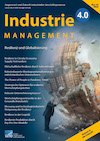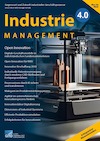Search


Bibtex
Cite as text
@Article{Hohenstein,
Cite-key = "Hohenstein2023TheP",
Year= "2023",
Number= "4",
Volume= "IM 39",
Pages= "25-30",
Journal = "Industrie 4.0 Management",
Title= "The Power of People in Pandemic Times – Driving Supply Chain Resilience through Corporate Culture",
Author= "Nils-Ole Hohenstein, Department of Supply Chain Management and Logistics, Cooperative State University (DHBW) Mannheim, Germany",
Doi= "https://doi.org/10.30844/IM_23-4_25-30",
Abstract= "The assertion “Our people are what set us apart from our rivals” is a common
statement made by nearly every company, highlighting the significance of
their people as the most valuable asset. Similarly, a corporate culture emphasizing
risk awareness and learning from experiences has played a key role in
shaping supply chain resilience (SCRES) amidst competitive dynamics in
response to the COVID-19 pandemic. Employee engagement, communication,
and collaboration, as dimensions of SC risk awareness, determine the
effectiveness of firms’ cultures in handling large-scale disruptions with robustness
and agility. Additionally, the COVID-19 crisis has had a positive
impact on firms’ learning orientation. The crucial necessity of digital supply
chain (SC) transformation to enhance SCRES under pandemic conditions has
further reinforced the need for dynamic adaptation and reconfiguration of
firms’ culture and employee skillsets through digital upskilling.",
Keywords= "COVID-19 pandemic, supply chain resilience, supply chain disruption, culture, learning, digital upskilling, digitalisation, transformation",
}
Nils-Ole Hohenstein, Department of Supply Chain Management and Logistics, Cooperative State University (DHBW) Mannheim, Germany(2023): The Power of People in Pandemic Times – Driving Supply Chain Resilience through Corporate Culture. IM 394(2023), S. 25-30. Online: https://doi.org/10.30844/IM_23-4_25-30 (Abgerufen 01.07.25)
Open Access
Abstract
Abstract
The assertion “Our people are what set us apart from our rivals” is a common statement made by nearly every company, highlighting the significance of their people as the most valuable asset. Similarly, a corporate culture emphasizing risk awareness and learning from experiences has played a key role in shaping supply chain resilience (SCRES) amidst competitive dynamics in response to the COVID-19 pandemic. Employee engagement, communication, and collaboration, as dimensions of SC risk awareness, determine the effectiveness of firms’ cultures in handling large-scale disruptions with robustness and agility. Additionally, the COVID-19 crisis has had a positive impact on firms’ learning orientation. The crucial necessity of digital supply chain (SC) transformation to enhance SCRES under pandemic conditions has further reinforced the need for dynamic adaptation and reconfiguration of firms’ culture and employee skillsets through digital upskilling.
Keywords
Schlüsselwörter
COVID-19 pandemic, supply chain resilience, supply chain disruption, culture, learning, digital upskilling, digitalisation, transformation
References
Referenzen
[1] Hohenstein, N.-O.: Supply chain risk management in the COVID-19 pandemic: strategies and empirical lessons for improving global logistics service providers’ performance. In: The International Journal of Logistics Management, 33 (2022) 4, pp. 1336-1365.
[2] Ivanov, D.; Dolgui, A.: Viability of intertwined supply networks: extending the supply chain resilience angles towards survivability. A position paper motivated by COVID-19 outbreak. In: International Journal of Production Research, 58 (2020) 10, pp. 2904-2915.
[3] Hohenstein, N.-O.; Feisel, E.; Hartmann, E.; Giunipero, L.: Research on the phenomenon of supply chain resilience. In: International Journal of Physical Distribution and Logistics Management, 45 (2015) 1/2, pp. 90-117.
[4] Van Hoek, R.: Research opportunities for a more resilient post-COVID-19 supply chain – closing the gap between research findings and industry practice. In: International Journal of Operations and Production Management, 40 (2020) 4, pp. 341-355.
[5] Sturm, S.; Hohenstein, N.-O.; Birkel, H.; Kaiser, G.; Hartmann, E.: Empirical research on the relationships between demand- and supply-side risk management practices and their impact on business performance. In: Supply Chain Management: An International Journal, 27 (2022) 6, pp. 742-761.
[6] Das, K.; Lashkari, R. S.: Risk readiness and resiliency planning for a supply chain. In: International Journal of Production Research, 53 (2015) 22, pp. 6752-6771.
[7] Chunsheng, L.; Wong, C. W.; Yang, C.-C.; Shang, K.-C.; Lirn, T.: Value of supply chain resilience: roles of culture, flexibility, and integration. In: International Journal of Physical Distribution and Logistics Management, 50 (2020) 1, pp. 80-100.
[8] Hoberg, K.; Thornton, L.; Wieland, A.: How to deal with the human factor in supply chain management?. In: International Journal of Physical Distribution & Logistics Management, 50 (2020) 2, pp. 151–158.
[9] Schein, E. H.: Culture: the missing concept in organization studies. In: Administrative Science Quarterly, 41 (1996) 2, pp. 229-240.
[10] Liu, H.; Ke, W.; Wei, K. K.; Gu, J. and Chen, J.: The Role of Institutional Pressures and Organizational Culture in the Firm’s Intention to Adopt Internet-Enabled Supply Chain Management Systems. In: Journal of Operations Management, 28 (2010) 5, S. 372-384.
[11] Hohenstein, N.-O.; Feisel, E.; Hartmann, E.: Human resource management issues in supply chain management research: a systematic literature review from 1998 to 2014. In: International Journal of Physical Distribution and Logistics Management, 44 (2014) 6, pp. 434-463.
[12] Sheffi, Y.: Preparing for the big one. In: IEE Manufacturing Engineer, 84 (2005) (5), pp. 12-15.
[13] Lund Pedersen, C.; Ritter, T.: Preparing Your Business for a Post Pandemic World. In: Harvard Business Review (2020). URL: hbr.org/2020/04/preparing-your-business-for-a-post-pandemic-world, time of access: 10 May 2023.
[14] Dubey, R.; Gunasekaran, A.; Childe, S. J.; Roubaud, D.; Fosso Wamba, S.; Giannakis, M.; Foropon, C.: Big data analytics and organizational culture as complements to swift trust and collaborative performance in the humanitarian supply chain. In: International Journal of Production Economics, 210 (2019), pp. 120-136.
[15] Mello, J. E.; Stank, T. P.: Linking firm culture and orientation to supply chain success. In: International Journal of Physical Distribution & Logistics Management, 35 (2005) 8, pp. 542–554
[16] Büyüközkan, G.; Göçer, F.: Digital Supply Chain: Literature review and a proposed framework for future research. In: Computers in Industry, 97 (2018), pp. 157–177.
[17] Ralston, P.; Blackhurst, J.: Industry 4.0 and resilience in the supply chain: a driver of capability enhancement or capability loss?. In: International Journal of Production Research, 58 (2020) 16, pp. 5006-5019.
[18] Hooks, T.; Macken-Walsh, A.; McCarthy, O.; Power, C.: The impact of a values-based supply chain [VBSC] on farm-level viability, sustainability and resilience: Case study evidence. In: Sustainability, 9 (2017) 2, pp. 267.
[19] Eisenhardt, K. M.: What is the Eisenhardt method, really? In: Strategic Organization 19 (2021) 1, pp. 147–160.
[20] Yin, R. K.: Case Study Research and Application: Design and Methods. Thousand Oaks, CA 2018.
[21] Gibbert, M.; Ruigrok, W. and Wicki, B.: What passes as a rigorous case study? In: Strategic Management Journal 29 (2008) 13, S. 1465-1474.
[22] Corbin, J. M.; Strauss, A.: Grounded theory research: procedures, canons, and evaluative criteria. In: Qualitative Sociology, 13 (1990) 1, S. 3-21.

 English
English
